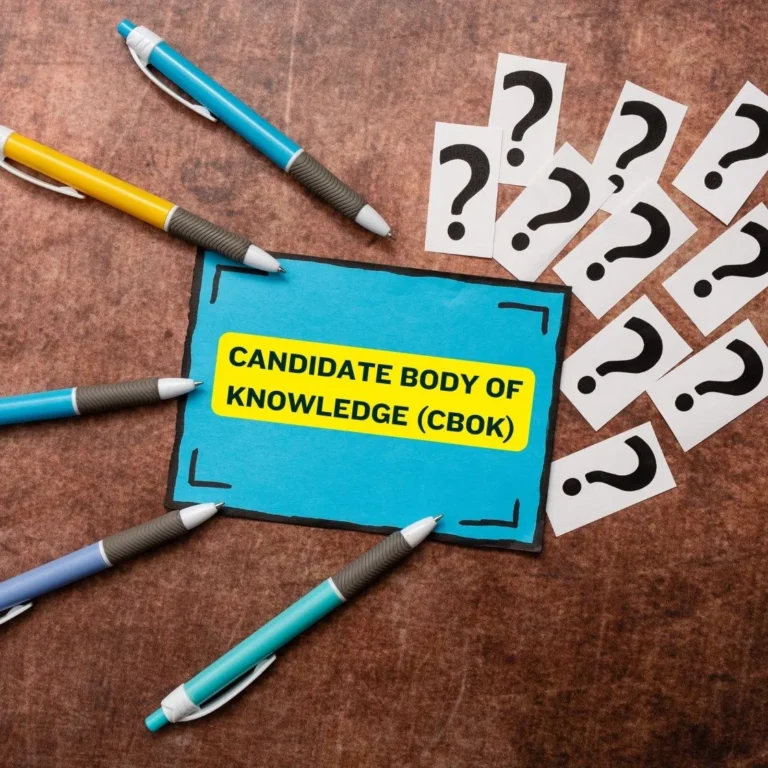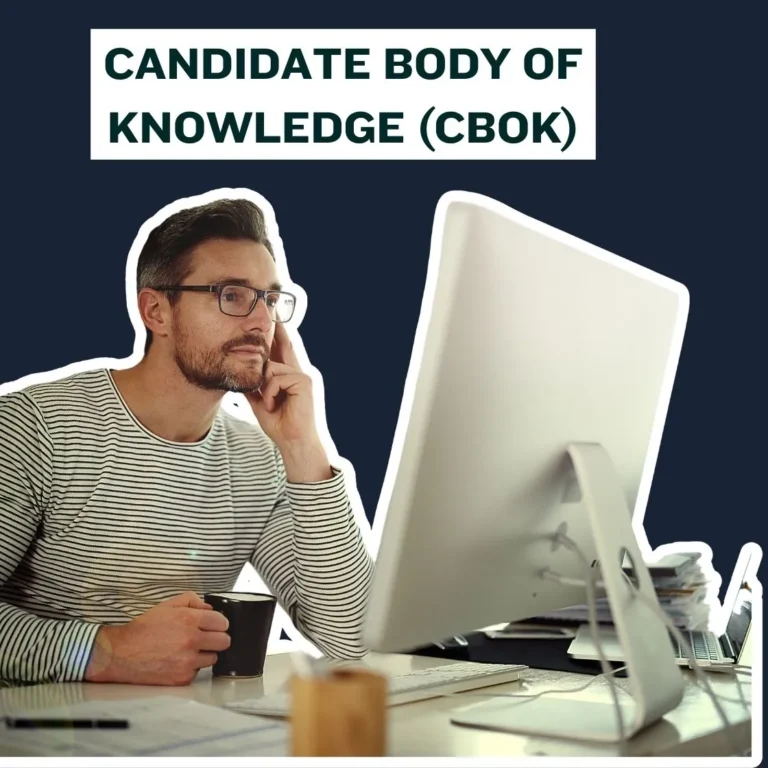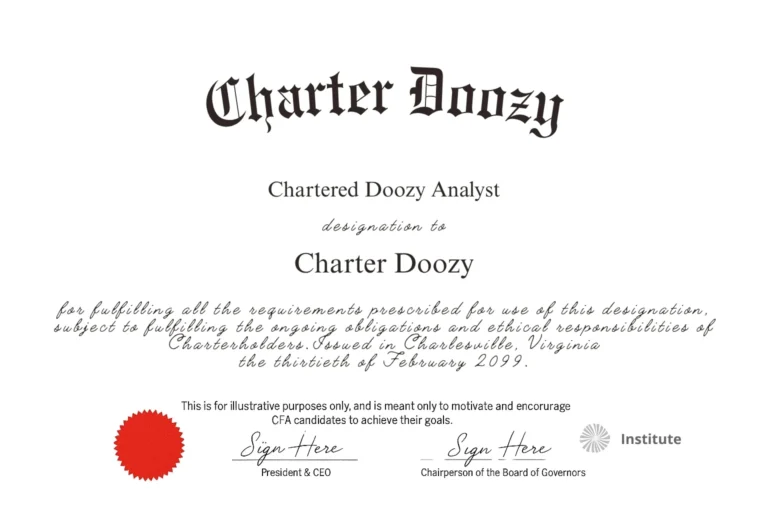Why the Candidate Body of Knowledge (CBOK) Matters
The CFA Exam’s Backbone
If the CFA exam were a house, the Candidate Body of Knowledge (CBOK) would be its foundation.
Every reading, learning objective, and exam question is built upon this structure.
Without it, the CFA curriculum would be just a collection of loosely related topics instead of a cohesive, carefully designed blueprint for mastering investment management.
Understanding the CBOK isn’t just about knowing what’s on the test.
It’s about knowing how to study smarter.
When you grasp its structure you are better placed to plan a path through the ocean of material.
Many candidates fail not because they lack intelligence or dedication, but because they fail to see the bigger picture of how the CFA exam is structured.
The CBOK provides that bigger picture.

Linking Education to Career
The CFA Program is not an academic qualification – it’s a professional qualification.
Unlike academic finance courses that often emphasize theoretical models, the CFA Program ensures that everything you learn applies directly to real-world investment management.
Every formula, case study, and concept serves a practical purpose.
The CBOK is what ensures that the curriculum doesn’t venture too far into the esoteric, and remains grounded in practical career-relevant knowledge.
For example:
- Financial Reporting & Analysis helps you read financial statements like an equity analyst.
- Fixed Income ensures you can assess bond risks like a portfolio manager.
- Ethics & Professional Standards teach you the real-world ethical dilemmas you’ll face in finance.
This is not just exam prep – it’s also career prep.
Understanding the CBOK allows you to filter out distractions and focus on what really matters – your career.

Designed by Experts for Future Experts
The CBOK isn’t static.
It’s a living, evolving framework that reflects the changing landscape of the investment profession.
Every year, the CFA Institute updates the curriculum to ensure it aligns with what firms actually need in their analysts, portfolio managers, and advisors.
This is why you’ll see new topics like ESG investing, behavioral finance, and artificial intelligence in finance becoming more prominent.
The CFA Institute actively consults top industry professionals, regulators, and academics to refine the CBOK so that CFA Charterholder remain ahead of the curve.
At its core, the CBOK is shaped by two major pillars:
- The Global Body of Investment Knowledge (GBIK) – A comprehensive knowledge base covering both mainstream and emerging investment concepts.
- The Candidate Body of Knowledge (CBOK) – A filtered subset of GBIK, carefully curated to reflect the knowledge, skills, and abilities that a newly minted CFA Charterholder should possess.
By staying aligned with real-world industry demands, the CBOK ensures that the CFA designation remains the gold standard in investment management.
When you master the CBOK you’re preparing for a successful, dynamic career in finance.

Breaking Down the CBOK – What You Need to Know
The Four Core Components
The Candidate Body of Knowledge (CBOK) is more than just a random collection of topics.
It’s a carefully structured framework designed to build the knowledge and skills investment professionals need.
If you understand how it’s structured, you can study with precision rather than feeling overwhelmed by the volume of material.
The CBOK consists of four core components:
1. Topic Areas – The Broad Categories That Define Your CFA Studies
The CFA curriculum is divided into ten key topic areas, covering everything from Ethics to Portfolio Management.
Each area represents a major field of knowledge that is essential for investment professionals.
Here’s how they break down:
- Ethics and Professional Standards – The foundation of trust in finance.
- Quantitative Methods – The statistical and mathematical tools for financial analysis.
- Economics – Understanding macro and microeconomic factors driving markets.
- Financial Reporting and Analysis – Reading and interpreting financial statements.
- Corporate Issuers – How companies make financial decisions.
- Equity Investments – Valuing stocks and understanding market dynamics.
- Fixed Income – Bonds, credit risk, and interest rate analysis.
- Derivatives – Options, futures, and swaps.
- Alternative Investments – Private equity, hedge funds, and real estate.
- Portfolio Management & Wealth Planning – Constructing and managing investment portfolios.
Each of these topics plays a crucial role in shaping an investment professional’s skill set, and understanding their weightings can help you prioritize your study efforts.
2. Learning Outcome Statements (LOS) – What You Need to Master in Each Topic
Every topic in the CFA curriculum is broken down into Learning Outcome Statements (LOS).
These statements define exactly what you need to know and be able to do for the exam.
Each LOS is structured as an action-oriented goal. For example:
- “Calculate and interpret the net present value (NPV) and internal rate of return (IRR) of an investment.”
- “Evaluate the impact of behavioral biases on investment decisions.”
The LOS statements guide your studying by telling you which concepts you need to understand, calculate, analyze, or apply.
They are your checklist for mastering the curriculum.
3. Weightings & Exam Structure – How Much Focus Each Topic Gets in the Exam
Not all topics are created equal.
The CFA Institute assigns weightings to each subject based on its importance in the real-world investment profession.
For example, Ethics is heavily weighted at every level because ethical decision-making is critical in finance.
On the other hand, some topics, like Derivatives, carry more weight in Level II than in Level I.
Understanding these weightings allows you to allocate your study time strategically.
Instead of spending equal time on everything, focus more on high-weighted topics to maximize your score.
4. Curriculum Readings – The Materials You’ll Be Tested On
The CFA curriculum is built around official readings, which contain the material you’ll be tested on.
These readings are updated annually to reflect the latest developments in finance.
Third-party Prep Providers also create supplementary material to help candidates by expounding or condensing the curriculum, as they see fit.

How the CBOK Evolves with the Investment Industry
The finance industry is constantly evolving, and so is the CBOK.
What was relevant ten years ago may be outdated today, which is why the CFA Institute updates the curriculum to reflect real-world industry changes.
Why CBOK Updates Matter
The investment world doesn’t stand still.
Markets shift, regulations change, and new asset classes emerge.
To remain the gold standard in investment education, the CBOK is updated annually based on:
- Feedback from industry professionals, CFA Charterholder, and employers.
- Changes in global financial regulations and market trends.
- Advancements in technology, data science, and financial modeling.
If the CBOK didn’t evolve, CFA Charterholder would be trained on outdated information – which would make the designation far less valuable.
The updates ensure that what you learn today is what you’ll actually use in your career.
The Rise of ESG Investing, AI in Finance, and Alternative Assets
Recent updates to the CBOK reflect some of the biggest shifts in finance, including:
ESG Investing (Environmental, Social, Governance)
- Investors are increasingly factoring in ESG criteria when making investment decisions.
- The CFA curriculum now includes more content on sustainable investing, corporate governance, and ethical considerations in ESG investments.
Artificial Intelligence & Big Data in Finance
- The role of AI, machine learning, and quantitative analysis is growing.
- The CFA Institute has expanded its coverage of alternative data sources, algorithmic trading, and fintech innovations.
Alternative Investments & Private Markets
- Hedge funds, venture capital, and private equity are becoming more prominent in institutional portfolios.
- The CBOK now includes more detailed readings on private market valuations, risk management, and liquidity concerns.
By staying aligned with cutting-edge developments, the CBOK ensures that CFA candidates are preparing for the future of finance.

What’s Inside the CFA Candidate Body of Knowledge?
Level I and II CBOK topic areas
I. Ethical and Professional Standards
- Professional Standards of Practice
- Ethical Practices
- Asset Manager Code of Professional Conduct
- Presentation of Performance Results (GIPS)
II. Quantitative Methods
- Time Value of Money
- Probability Distributions and Concepts
- Sampling and Estimation
- Regression Analysis
- Artificial Intelligence/Machine Learning and Big Data Analysis and Applications
- Time-Series Analysis
- Back-testing, Simulation, and Scenario Analysis
III. Economics
- Market Forces of Supply and Demand
- The Firm and Industry Organization
- Business Cycles
- Inflation and Deflation
- International Trade and Capital Flows
- Currency Exchange Rates
- Monetary System, Monetary and Fiscal Policy
- Economic Growth and Development
- Effects of Regulations
- Economic Analysis and Setting Capital Market Expectations
- Effects of Geopolitics on Economies and Investment Markets
- Applications of Economic Factors in the Investment Process
IV. Financial Statement Analysis
- Analysis of Financial Statements
- Financial Reporting Quality
- Analysis of Off-Balance-Sheet Assets and Liabilities
- Analysis of Stock Compensation and Other Employee Benefits
- Analysis of Intercorporate Investments and Business Combinations
- Analysis of Global Operations
- Building a Company Financial Model
- Ratio and Financial Analysis
- Financial Analysis of Banks and Insurance Companies
- ESG considerations in Financial Statement Analysis
V. Corporate Issuers
- Corporate Structures and Strategies
- Corporate Ownership and Governance
- Risk Factors (including environmental and social)
- Corporate Financing Decisions
- Corporate Actions, Combinations, and Restructuring
VI. Equity Investments
- Types of Equity Securities and Markets
- Fundamental Equity Analysis
- Valuation of Individual Equity Securities
- Equity Market Valuation
- ESG considerations in Equity Investments
VII. Fixed Income
- Types of Fixed Income Securities and Markets
- Fundamental Fixed Income
- Term Structure Determination and Yield Spreads
- Valuation of Individual Fixed Income Securities
- Analysis of Interest Rate Risk
- Analysis of Credit Risk
- Valuing Bonds with Embedded Options
- Structured Products
- ESG considerations in Fixed Income
VIII. Derivatives
- Types of Derivative Instruments and Markets
- Valuation of Forwards and Futures Contracts
- Valuation of Option Contracts
- Valuation of Swap Contracts
- Currency Management
- Risk Management (including Environmental Risk)
IX. Alternative Investments
- Types of Alternative Investments
- Real Estate
- Real Assets (including Infrastructure, Timber and Farm Land)
- Private Capital (including Private Equity, Private Credit and Venture Capital)
- Hedge Funds
- Commodities
- ESG considerations in Alternative Investments
X. Portfolio Management and Wealth Planning
- The Investment Policy Statement
- Modern Portfolio Management Concepts
- Investment Vehicles (including ETFs and Mutual Funds)
- Market Efficiency and Passive Investing
- Market Indexes
- Behavioral Finance
- Environmental, Social, and Governance (ESG) Investing
- Management of Individual/Family Investor Portfolios
- Tax Impact of Investment Decisions
- Management of Institutional Investor Portfolios
- Investment Manager Selection
- Asset Allocation
- Portfolio Construction and Revision
- Currency Management
- Liability – Driven Investments (including Asset Liability Management and Goal-Based Investing)
- Risk Management (including environmental risk)
- Execution of Portfolio Decisions (including Trading and Market Microstructure)
- Performance Attribution and Appraisal
Level III topic areas
I. Ethical and Professional Standards
- Professional Standards of Practice
- Ethical Practices
- Asset Manager Code of Professional Conduct
II. Derivatives and Risk Management
- Types of Derivative Instruments and Markets
- Valuation of Forwards and Futures Contracts
- Valuation of Option Contracts
- Valuation of Swap Contracts
- Currency Management
- Risk Management (including Environmental Risk)
III. Portfolio Construction
- The Investment Policy Statement
- Modern Portfolio Management Concepts
- Investment Vehicles (including ETFs and Mutual Funds)
- Market Efficiency and Indexed Investing
- Market Indexes
- Behavioral Finance
- Environmental, Social, and Governance (ESG) Investing
- Management of Individual/Family Investor Portfolios
- Tax Impact of Investment Decisions
- Management of Institutional Investor Portfolios
- Portfolio Construction and Revision
- Equity Portfolio Management
- Fixed Income Portfolio Management
- Alternative Investments Portfolio Management
- Liability – Driven Investments (including Asset Liability Management and Goal-Based Investing)
IV. Asset Allocation
- Economic Analysis and Setting Capital Market Expectations
- Asset Allocation
- Liability – Driven Investments (including Asset Liability Management and Goals-Based Investing)
V. Performance Measurement
- Performance Attribution and Appraisal
- Presentation of Performance Results (GIPS)
- Investment Manager Selection
- Execution of Portfolio Decisions (including Trading and Market Microstructure)
Level III topic areas
Portfolio Management Pathway
- Index Investing
- Fixed Income Portfolio Management
- Equity Portfolio Management
- Execution of Portfolio Decisions (including Trading and Market Microstructure)
- Management of Institutional Investor Portfolios
- Liability – Driven Investments (including Asset Liability Management and Goal-Based investing)
Private Markets Pathway
- Deal origination, screening, analysis, and valuation
- Deal structuring, financing, and negotiation
- Management of Assets, execution of value creation strategies, and exit strategies
- Fund vehicles, agreements, and structures
- Capital flows: raising capital, distributing returns, and collecting fees/carried interest
- Private Asset classes: Market context, Investment strategies and Investment process
- Measures of fund level returns and performance at portfolio company level
Private Wealth Pathway
- Private Wealth Management Industry
- Client Management
- Wealth Planning
- Investment Management
- HNW client profiling & Asset Allocation
Doozy Digest
A newsletter for CFA candidates
Subscribe for:
✔ Insightful tips
✔ Expert advice
✔ Career motivation
✔ Exam inspiration
Stay updated and subscribe today!
Final Takeaway
The CBOK is more than just an academic syllabus.
Embedded in the CBOK is a career blueprint that reflects the real demands of the investment profession.
By understanding its four core components and how it evolves with industry trends, you can:
- Prioritize your study efforts effectively
- Stay ahead of industry developments
- Position yourself as a future-ready investment professional
In short, the CBOK is what you need to pass the CFA exam AND what you need to succeed in your career.

